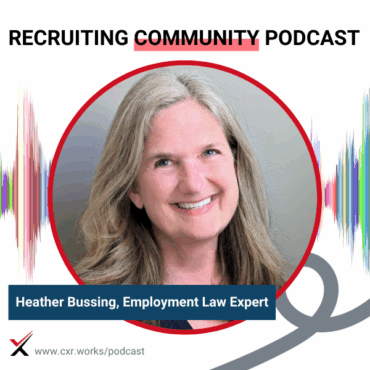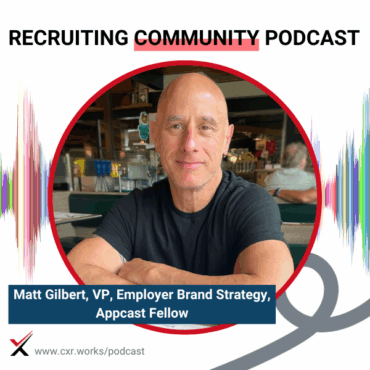
The Employer Brand Equation: Who Sets the Value?
Who really controls employer brand—candidates, employees, or the C-suite? Appcast’s Matt Gilbert joins CXR to unpack strategy, ownership, and long-term value.
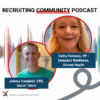 play_arrow
play_arrow
AI in Talent Acquisition Cami Grace
 play_arrow
play_arrow
Balancing Strategy and Tactics: Melissa Thompson’s Career Crossroads Cami Grace
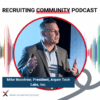 play_arrow
play_arrow
Real-Time Jobs Data and the TA Advantage Cami Grace
 play_arrow
play_arrow
20+ Years at Dell and Beyond: Jennifer Newbill’s Career Crossroads Cami Grace
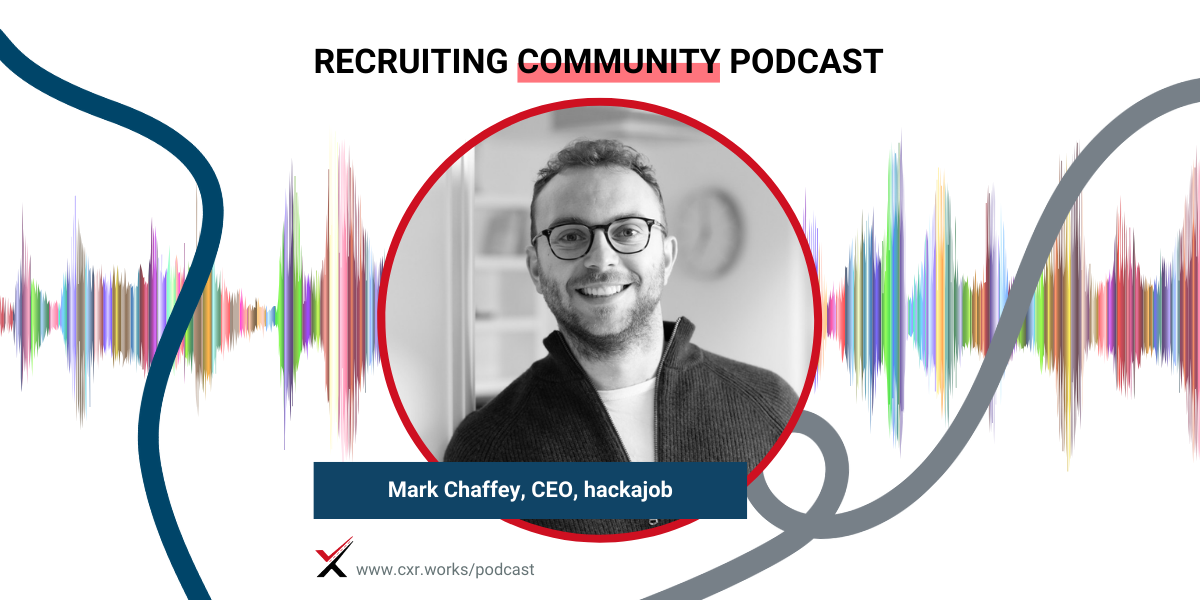
Featured Guests:
Mark Chaffey, CEO and Co-founder, Hackajob
Hosts:
Chris Hoyt, President, CareerXroads
Gerry Crispin, Co-founder, CareerXroads
Episode Overview:
Chris Hoyt and Gerry Crispin talk with Mark Chaffey, CEO of Hackajob, about the shift from assistive to agentic AI in recruiting. Mark outlines how Hackajob is using AI to transform matching, screening, and even interviewing, and what it means for the future role of recruiters. The discussion covers legal risks, AI cost trends, candidate fairness, and how organizations can prepare for a future shaped by autonomous agents.
Key Topics:
Definitions and distinctions between assistive and agentic AI
Real-world applications of AI in sourcing, screening, and scheduling
How Hackajob Intelligence matches candidates based on nuanced data
The decline of resume-based hiring and the rise of AI-generated applications
Building AI agents that join intake calls to extract hiring signals
Legal, ethical, and adoption risks surrounding autonomous AI in TA
The falling cost of AI and implications for tool development
The importance of auditability, explainability, and transparency in AI systems
What TA leaders need to know to remain accountable for AI-driven decisions
Evolving recruiter roles and the need for system-of-work approaches
Notable Quotes:
“Agentic AI executes the task autonomously. No human in the loop.” — Mark Chaffey
“Everyone should get a chance to showcase themselves. A 2D resume just doesn’t cut it anymore.” — Mark Chaffey
“Intelligence is heading toward zero cost.” — Mark Chaffey
“Every vendor should be able to explain how their AI makes decisions.” — Mark Chaffey
“We’re building a system of work—not just a system of record.” — Mark Chaffey
Takeaways:
Agentic AI has arrived and is already reshaping technical hiring. Mark Chaffey emphasizes the need for transparency, consistency, and fairness as TA functions integrate autonomous tools. While routine tasks may be automated, recruiters remain essential in driving human-centered experiences and managing AI responsibly.
Want more conversations like this?
Subscribe to the CXR podcast and explore how top talent leaders are shaping the future of recruiting. Learn more about the CareerXroads community at cxr.works.
Announcer: Welcome to the Recruiting Community Podcast, the go-to channel for talent acquisition leaders and practitioners. This show is brought to you by CXR, a trusted community of thousands connecting the best minds in the industry to explore topics like attracting, engaging, and retaining top talent. Hosted by Chris Hoyt and Jerry Crispin.
We are thrilled to have you join the conversation.
Chris Hoyt: Well, I’m Chris Hoyt. I’m the president of CXR. I’m with Jerry Crispin, co-founder of CXR, and we are your hosts for the next 30 or 40 minutes. We’re bringing you industry insights and updates in the form of fun conversation, all brought to you by the CXR community.
Today we’ve got Mark on. He’s the CEO and founder of Hackajob, and we’re going to talk about the rise of agentic AI and what real-world applications might look like for the future of TA—if anything.
If you’re watching us on YouTube, Facebook, LinkedIn, or elsewhere, you can hit like, subscribe, or drop a comment. And if you want to see past or future episodes, just go to cxr.works/podcast.
Mark is a CXR community member, and this is an ad-free labor of love. Nobody paid to be on here—we invited Mark because he’s doing great work and we love his take.
So, Mark, let’s jump in. For those who haven’t met you yet—maybe not even at a wedding—give us the elevator pitch. Who is Mark, and why should we be listening to you today?
Mark Chaffey: Awesome. Chris and Jerry, thank you so much for having me on and for all the work you do for our community—it means a lot.
Quick intro on me: I’m Mark Chaffey, co-founder and CEO at Hackajob. We started the company 10 years ago while in our final year at university in London, and it’s been a wild ride ever since. We’ve always focused on technical hiring.
Last summer, we launched Hackajob Intelligence, our AI matching platform. I’m just obsessed with how the TA world is changing—frankly, how the world is changing faster than ever before. And not just because of people posting crazy tweets—though there’s plenty of that, too.
Chris Hoyt: Love it. For those unfamiliar with Hackajob, give us a quick overview of what you do.
Mark Chaffey: Hackajob is the largest dedicated professional network for tech workers. We’ve got over a million members across the US, UK, and India who engage with our community. For employers, we offer a marketplace to hire talent.
Our original innovation was flipping the model—rather than candidates applying to jobs, companies apply to candidates. That worked really well during tight labor markets with high demand. We were seeing 90% response rates.
But as the market changed, the bigger challenge became matching. Companies are now drowning in hundreds or thousands of irrelevant applications. So our focus has shifted to precision matching. With Hackajob Intelligence, it now takes about nine matches to make a hire—compared to a report from Ashby showing 350 applications per hire. AI is a big part of that.
Chris Hoyt: Love it. So today’s topic is assistive vs. agentic AI as it applies to recruiting. Let’s start there—how do you define those two things?
Mark Chaffey: Great question. First, let’s acknowledge that every vendor jumps on buzzwords fast, and not everything labeled “AI” is really AI.
That said, assistive AI helps a human complete a task. For example, a CRM might give you a match score—75% fit, B-grade, etc.—to help a recruiter decide. But the human is still making the call.
Agentic AI, on the other hand, executes the task autonomously. You give it a goal—“review these 100 resumes and pick the top 10”—and it does it. No human in the loop.
Chris Hoyt: How close are we, really, to crossing into that agentic zone?
Mark Chaffey: The technology is already there. I’ve seen things in the last four weeks that are mind-blowing. The challenge is adoption—some organizations are banning integrations altogether. Risk tolerance varies wildly.
In the hiring funnel, earlier stages are more ripe for automation. The closer you get to making a hiring decision, the more legal risk there is. Think of the recent Workday case—companies are rightly cautious.
Chris Hoyt: Talk more about matching. What’s broken, and how is AI improving it?
Mark Chaffey: Matching has been overhyped for 15 years. Vendors often rely on job descriptions, but those are usually poor reflections of what hiring managers actually want.
We ask hiring managers, “Who’s the best person you’ve worked with in this role?” Their answers are never just about hard skills—they talk about qualities, growth, team impact. None of that is in a resume.
Now, we can use AI to match on those more abstract, real-world qualities.
Gerry Crispin: It’s also about how we collect candidate data. Resumes are messy, often written by other AIs. We need more consistent, high-quality data at the top of the funnel. But candidates also need to feel respected and given a real shot.
Mark Chaffey: Exactly. And recruiters add a lot of intuition that’s often not captured. We’re building agents that join job intake calls and extract all that nuance—what’s actually important, how they want to screen, etc. That’s far more effective than relying on a static JD.
Chris Hoyt: So now we’re automating the recruiter’s traditional role—translating between the hiring manager and the candidate. Fascinating.
Gerry Crispin: And we’re raising the bar. No recruiter can interview 100 people consistently in four days and gather legally defensible data. But an AI could, if trained properly.
Mark Chaffey: Right. And that’s key—consistency and fairness. Everyone should get a chance to showcase themselves. A 2D resume just doesn’t cut it anymore.
Chris Hoyt: So what parts of the TA process are most ready for autonomous AI now?
Mark Chaffey: Screening is a big one. One customer got 10,000 applications in a month with six recruiters screening them all manually. That’s insane.
That should be assisted or automated—bucket applications, surface top talent. Another one is interview scheduling. That doesn’t even need AI, but AI is making it smoother.
Even interviewing itself—AI can do structured, consistent interviews better than humans in many cases.
Chris Hoyt: And the cost? That’s always the concern.
Mark Chaffey: Costs are dropping fast. When we launched our latest version, it was expensive. But then GPT-4 dropped and reduced costs by 18x. Just today, Sam Altman said OpenAI’s prices are down 80%. Intelligence is heading toward zero cost.
Chris Hoyt: That’s wild. But I saw that OpenAI still isn’t profitable despite millions in revenue. Something’s gotta give, right?
Mark Chaffey: True. But competition helps. Meta, Google, and others have massive cash reserves and are pushing costs down further. We’re benefiting from that race.
Chris Hoyt: Let’s talk accountability. When AI acts without human oversight, who’s responsible?
Mark Chaffey: The TA leader must be accountable—same as they are for decisions made by team members. The key is explainability. Every vendor should be able to explain how their AI makes decisions. There should be logs, transparency, audit trails.
Gerry Crispin: We’re going to need audit capacity within TA teams. People who understand AI, compliance, and psychometrics. And we need to ask better questions of vendors—about certification, training data, fairness.
Chris Hoyt: Quick plug: cxr.works/iip. That’s where folks can get our open-source AI RFP template—28 questions for evaluating AI vendors. Free to download, use, or edit. If your vendor even hints at AI, make them fill that out.
Mark Chaffey: It’s a brilliant resource. Everyone should use it.
Chris Hoyt: So let’s go back to TA leaders—will AI amplify recruiter capabilities or replace parts of the role?
Mark Chaffey: It’ll do both. The best tools will amplify recruiters—help with tasks like crafting interview questions or analyzing resumes. But it will also replace repetitive tasks.
Our mental model is building a system of work—not just a system of record like an ATS. And great recruiters will continue to shine where it matters: stakeholder management and candidate experience. Those are inherently human.
Chris Hoyt: Love that. One last thought—these new AI build tools are wild. I’m not a coder, but I built a working app in a week with a no-code AI assistant. It makes me wonder how many new builders we’re about to see enter the space.
Mark Chaffey: It’s incredible. These tools empower anyone to create MVPs quickly. But real enterprise apps still need security, QA, and standards. So you’ll see lots of amazing prototypes—but still a role for serious engineering.
Chris Hoyt: Alright Mark, we end every show with this: if you were going to write a book based on today’s conversation, what would you call it?
Mark Chaffey: Ties into our UK Fest theme this year—how AI agents will help you fall in love with recruitment again.
Chris Hoyt: I love that! Professional romance—with robots. Who gets the first signed copy?
Mark Chaffey: Jerry—if he gives me a nice bottle of wine.
Gerry Crispin: I like that answer!
Mark Chaffey: But seriously, probably someone from our early customer base who believed in us when we were just getting started. Someone like Luke Coleman or Ed Ross—folks who’ve been on the journey with us since 2015. We wouldn’t be here without them.
Chris Hoyt: Great answer. Mark, we know you’re busy—thanks so much for joining us. Really appreciate your time.
Mark Chaffey: Chris, Jerry—this has been such a fun conversation. I appreciate you both. Thank you.
Chris Hoyt: Always good to see your face, man. Travel safe!
Announcer: Thanks for listening to the Recruiting Community Podcast, where talent acquisition leaders connect, learn, and grow together. Be sure to visit cxr.works/podcast to explore past episodes, see what’s coming up next, and find out how you can join the conversation.
Whether you’ve got insights to share or want to be a guest on the show, we’d love to hear from you. If you’re interested in learning more about becoming a member of the CXR community, visit us at www.cxr.works. We’ll catch you in the next episode.
Tagged as: AI Compliance, AI matching, Hackajob Intelligence, Hackajob, GPT-4, Talent Acquisition, resume screening, Human Resources, assistive AI, Data, TA automation, Hiring, Meets Talent, agentic AI, Real, AI, OpenAI, World Wins.

Who really controls employer brand—candidates, employees, or the C-suite? Appcast’s Matt Gilbert joins CXR to unpack strategy, ownership, and long-term value.
